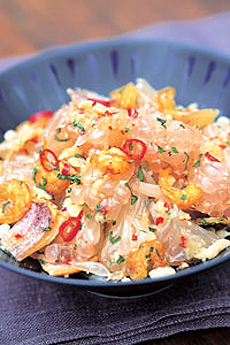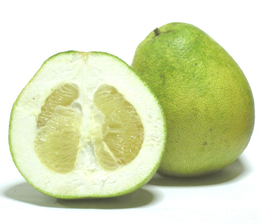

You don’t need to search for a great Vietnamese restaurant—just make this salad at home. It’s delicious and low-calorie.
September 2007
|
 |
Recipe: Pomelo & Dried Squid Salad
A Vietnamese-Inspired Spicy Salad Recipe
This Vietnamese-inspired salad with a spicy dressing uses dried seafood, but the result is lively and refreshing. Drying is known to increase the levels of natural umami in many foods, so the dried shrimp and squid ensure that this dish has plenty of “the fifth taste.” As a first course or a side dish, it’s a delight. To turn it into a luncheon dish, put it on a bed of Asian vegetables like bean sprouts and bok choy, or serve it with rice. You can substitute artificial sweetener for the sugar and leave off the ground peanuts for a truly diet dish; but even fully loaded, it’s low-calorie.
The recipe uses the the pomelo, or Chinese grapefruit (Citrus maxima, it is also spelled pummelo and pommelo, and is known by other names including jabong, shaddock and jeruk Bali). Native to Southeast Asia and Malaysia, pomelo is the largest citrus fruit, and is now found in many U.S. supermarkets. It is sweeter and has a much thicker skin than the common grapefruit* (Citrus paradisi), which is actually a hybrid of the pomelo and the orange.
*While grapefruit is ubiquitous, it is actually a botanical youngster, little more than 300 years old. The seeds of the pomelo were brought to the West Indies by Captain Shaddock, a 17th century British ship commander, in 1693. It crossbred in the wild with an orange (and in fact was the size of an orange), but was acidic and bitter compared to sweet fruits, and not popular. It received its name from a 19th-century naturalist who noticed that the fist-sized fruit appeared to grow in clusters like grapes. The grapefruit first appeared in the U.S. in 1823, when Count Odette Phillipe brought the seeds from the Bahamas to Florida. The plants thrived, but the fruit was not popular. The first grapefruit nursery was established in 1870. The first Florida grapefruit shipped to New York and Philadelphia in 1885 created interest and was the beginning of a serious commercial grapefruit industry. New grapefruit varieties, including those with pink and red flesh, were developed in the early 1900s and became popular. In 1929, a red grapefruit mutation, growing on a tree that was producing pink grapefruits, became a new cultivar named Ruby Red—the first grapefruit to be granted a U.S. patent.
You can purchase dried shrimp and squid, as well as the fish sauce and other ingredients in this recipe, at most Asian markets, or on Amazon.com. If you don’t have access to these ingredients, though, or would rather work with more familiar ingredients, just adapt the concept. Make a salad with fresh-cooked shrimp, squid, pomelo and mint with the same spicy dressing, and serve it on a bed of greens. Delicious!
Serves 4.
Ingredients
For The Salad
- 1 large pomelo*, separated into segments
- 1-1/2 tablespoons (20g) medium dried shrimps, soaked and fried
- 1/2 a dried squid (3/4 cup or 160g), grilled and slightly beaten, torn into small pieces
- 3 teaspoons (15g) rau ram (Vietnamese coriander) or mint leaves, finely chopped
*Grapefruit can be substituted for pomelo, but it is more sour than pomelo. The sweeter pink grapefruit is a better substitute.
For The Dressing
- 1 to 3 cloves garlic, crushed
- 2 small red chiles, minced
- 2 tablespoons fish sauce
- 2 tablespoons lime juice*
- 3 tablespoons sugar
- ½ teaspoon umami seasoning
(MSG)
- 1 small red chile, sliced
- 2 tablespoons roasted ground
peanuts
|

Pomelo, the largest citrus fruit. Photo courtesy of
Wikipedia. |
*Made of anchovies, fish sauce (nam pla) is used as a primary seasoning in Vietnamese and Thai dishes instead of salt or soy sauce. It can be found at any Asian market or online.
Directions
- Combine all the salad ingredients with half the amount of peanuts in a large bowl.
- Mix all the dressing ingredients and stir well. The mixture is perfect if it tastes sweet and sour.
- Just before serving, pour the dressing over the salad and stir well. Place the salad on a plate and garnish with the remaining peanuts and sliced chiles.
Recipe and recipe image courtesy of Umami Information Center. © 2007 UMAMI Information Center. All rights reserved. Additional material © Copyright 2005-
Lifestyle Direct, Inc. All rights reserved. Images are the copyright of their respective owners.

|



